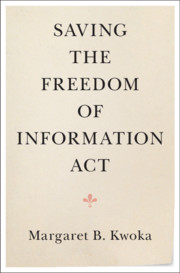
-
Select format
-
- Publisher:
- Cambridge University Press
- Publication date:
- 08 October 2021
- 14 October 2021
- ISBN:
- 9781108697637
- 9781108482745
- 9781108710893
- Dimensions:
- (229 x 152 mm)
- Weight & Pages:
- 0.54kg, 272 Pages
- Dimensions:
- (229 x 152 mm)
- Weight & Pages:
- 0.41kg, 272 Pages
You may already have access via personal or institutional login
Book description
Enacted in 1966, The Freedom of Information Act (or FOIA) was designed to promote oversight of governmental activities, under the notion that most users would be journalists. Today, however, FOIA is largely used for purposes other than fostering democratic accountability. Instead, most requesters are either individuals seeking their own files, businesses using FOIA as part of commercial enterprises, or others with idiosyncratic purposes like political opposition research. In this sweeping, empirical study, Margaret Kwoka documents how agencies have responded to the large volume of non-oversight requesters by creating new processes, systems, and specialists, which in turn has had a deleterious impact on journalists and the media. To address this problem, Kwoka proposes a series of structural solutions aimed at shrinking FOIA to re-center its oversight purposes.
Reviews
‘Margaret Kwoka has done a great service in illuminating how one of the world's most famous transparency laws works, and fails to work. Combining pathbreaking empirical research with insightful critique and sensible proposals for reform, Saving the Freedom of Information Act is essential reading for all who care about FOIA.'
David Pozen - Columbia Law School, New York
Contents
Metrics
Altmetric attention score
Full text views
Full text views help Loading metrics...
Loading metrics...
* Views captured on Cambridge Core between #date#. This data will be updated every 24 hours.
Usage data cannot currently be displayed.
Accessibility standard: Unknown
Why this information is here
This section outlines the accessibility features of this content - including support for screen readers, full keyboard navigation and high-contrast display options. This may not be relevant for you.
Accessibility Information
Accessibility compliance for the PDF of this book is currently unknown and may be updated in the future.


